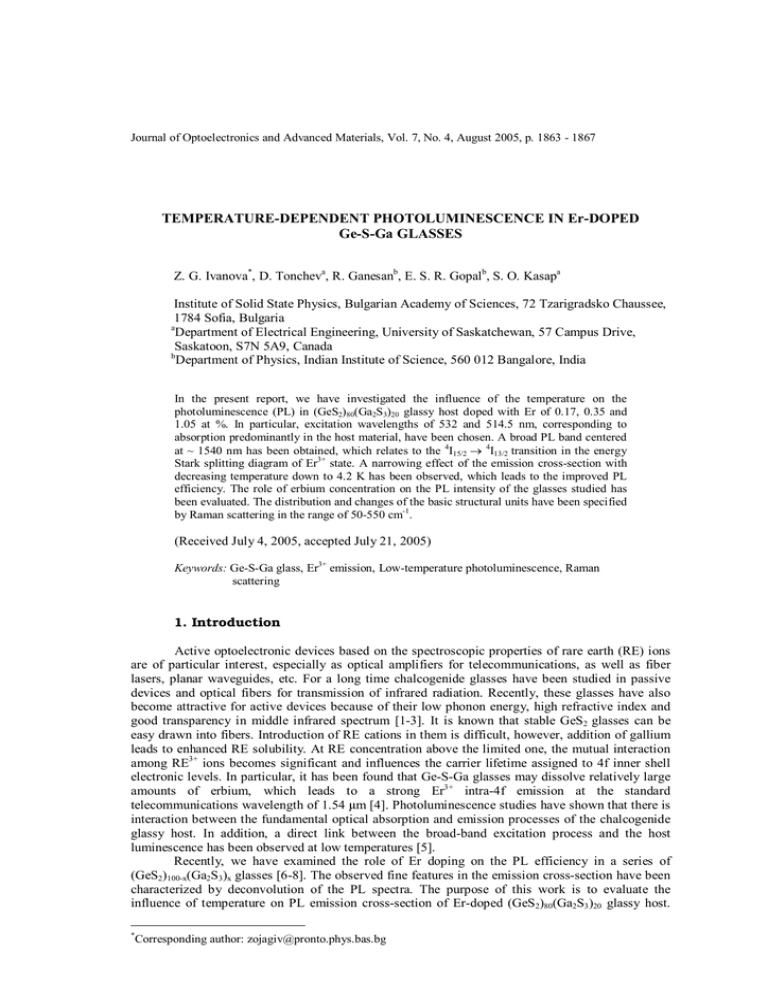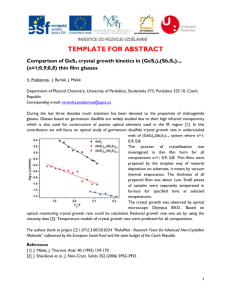TEMPERATURE-DEPENDENT PHOTOLUMINESCENCE IN Er-DOPED Ge-S-Ga GLASSES
advertisement

Journal of Optoelectronics and Advanced Materials, Vol. 7, No. 4, August 2005, p. 1863 - 1867 TEMPERATURE-DEPENDENT PHOTOLUMINESCENCE IN Er-DOPED Ge-S-Ga GLASSES Z. G. Ivanova*, D. Toncheva, R. Ganesanb, E. S. R. Gopalb, S. O. Kasapa Institute of Solid State Physics, Bulgarian Academy of Sciences, 72 Tzarigradsko Chaussee, 1784 Sofia, Bulgaria a Department of Electrical Engineering, University of Saskatchewan, 57 Campus Drive, Saskatoon, S7N 5A9, Canada b Department of Physics, Indian Institute of Science, 560 012 Bangalore, India In the present report, we have investigated the influence of the temperature on the photoluminescence (PL) in (GeS2)80(Ga2S3)20 glassy host doped with Er of 0.17, 0.35 and 1.05 at %. In particular, excitation wavelengths of 532 and 514.5 nm, corresponding to absorption predominantly in the host material, have been chosen. A broad PL band centered at ~ 1540 nm has been obtained, which relates to the 4I15/2 → 4I13/2 transition in the energy Stark splitting diagram of Er3+ state. A narrowing effect of the emission cross-section with decreasing temperature down to 4.2 K has been observed, which leads to the improved PL efficiency. The role of erbium concentration on the PL intensity of the glasses studied has been evaluated. The distribution and changes of the basic structural units have been specified by Raman scattering in the range of 50-550 cm-1. (Received July 4, 2005, accepted July 21, 2005) Keywords: Ge-S-Ga glass, Er3+ emission, Low-temperature photoluminescence, Raman scattering 1. Introduction Active optoelectronic devices based on the spectroscopic properties of rare earth (RE) ions are of particular interest, especially as optical amplifiers for telecommunications, as well as fiber lasers, planar waveguides, etc. For a long time chalcogenide glasses have been studied in passive devices and optical fibers for transmission of infrared radiation. Recently, these glasses have also become attractive for active devices because of their low phonon energy, high refractive index and good transparency in middle infrared spectrum [1-3]. It is known that stable GeS2 glasses can be easy drawn into fibers. Introduction of RE cations in them is difficult, however, addition of gallium leads to enhanced RE solubility. At RE concentration above the limited one, the mutual interaction among RE3+ ions becomes significant and influences the carrier lifetime assigned to 4f inner shell electronic levels. In particular, it has been found that Ge-S-Ga glasses may dissolve relatively large amounts of erbium, which leads to a strong Er3+ intra-4f emission at the standard telecommunications wavelength of 1.54 m [4]. Photoluminescence studies have shown that there is interaction between the fundamental optical absorption and emission processes of the chalcogenide glassy host. In addition, a direct link between the broad-band excitation process and the host luminescence has been observed at low temperatures [5]. Recently, we have examined the role of Er doping on the PL efficiency in a series of (GeS2)100-x(Ga2S3)x glasses [6-8]. The observed fine features in the emission cross-section have been characterized by deconvolution of the PL spectra. The purpose of this work is to evaluate the influence of temperature on PL emission cross-section of Er-doped (GeS2)80(Ga2S3 )20 glassy host. * Corresponding author: zojagiv@pronto.phys.bas.bg 1864 Z. G. Ivanova, D. Tonchev, R. Ganesan, E. S. R. Gopal, S. O. Kasap The role of erbium content on the local structural modification in the glassy network has been specified by Raman scattering. 2. Experimental Glasses with starting compositions of (GeS2)80(Ga2S3)20 : xEr2S3, where x=0.3, 0.6 and 1.8 mol % (corresponding to 0.17, 0.35 and 1.05 at % Er, respectively) were prepared from initial GeS2 , Ga2S3 and Er2S3 components by conventional rapid quenching of melts in ice water. They were synthesized into evacuated (~10-3 Pa) silica ampoules and heated up to 1000 oC for 24 hours at rate of 2-4 oC min-1 by an employed stepwise regime (at 250, 550 and 750 oC for 2 h) [6,7]. The amorphous state and uniformity of the samples were checked by X-ray diffraction and electron microscopy. Photoluminescence spectra were measured at room temperature using 532 nm excitation by an ORIEL Cornerstone 1/8 m monochromator and an ORIEL cooled InGaAs photodiode [6], and at low temperatures of 77 and 4.2 K – using 514.5 nm excitation by a Fourier-Transform Photoluminescence Spectrometer (MIDAC Corp. USA) and detected by a liquid nitrogen cooled Ge photo diode [7]. Raman spectra were measured at room temperature in backscattering geometry with a Bruker IFS-55 FRA 106 FT spectrometer. 3. Results and discussion PL intensity (a. u.) The photoluminescence spectra of the glasses studied at room temperature are presented in Fig. 1. The observed PL band at the chosen excitation, related to the host absorption, is centred around 1540 nm, i.e. it is attributed to the 4I15/2→4I13/2 transition in the energy Stark splitting diagram of Er3+ ions. It is clearly seen that while a content of 0.17 at % Er is not sufficient to induce active emission, the PL peak at 0.35 at % Er is quite definitive. A rather strong emission cross-section exhibits when the Er concentration is three times larger. The deconvolution of this spectrum has shown [6] that the broad PL band is mainly due to high intensities of the sub-bands centred at ~ 1520 and 1553 nm. 3 2 1 1450 1500 1550 1600 1650 Wavelength (nm) Fig. 1. PL spectra of the glasses studied at room temperature for: (1) 0.17, (2) 0.35 and (3) 1.05 at % Er-doping. Temperature-dependent photoluminescence in Er-doped Ge-S-Ga glasses 1865 PL intensity (a. u.) The photoluminescence spectra at 77 and 4.2 K are summarized in Figs. 2 and 3, respectively. Compared to the spectra at 300 K (Fig. 1), the PL bands are sharper and more intensive, which can be attributed to changes in the partial intensities of the sub-bands. In addition, the peak intensity at 0.17 at % Er-doping is higher. It has been found [7] that at 77 K the total PL band for maximum Er-doping of 1.05 at % may be presented as a sum of four Gaussian sub-bands, centred at ~ 1520, 1538, 1546 and 1577 nm. The broadened PL line is mainly due to the enhanced height of the subband at 1575 nm. At 4.2 K, the sub-band at 1538 nm drastically increases at the expense of that at 1577 nm, while that at 1520 nm disappears and as a result the total PL peak becomes rather narrow. 3 2 1 1450 1500 1550 1600 1650 Wavelength (nm) PL intensity (a. u.) Fig. 2. PL spectra of the glasses studied at 77 K for: (1) 0.17, (2) 0.35 and (3) 1.05 at % Er-doping. 3 2 1 1450 1500 1550 1600 1650 Wavelength (nm) Fig. 3. PL spectra of the glasses studied at 4.2 K for: (1) 0.17, (2) 0.35 and (3) 1.05 at % Er-doping. The influence of temperature on the observed PL narrowing effect can be better pronounced with the corresponding normalized PL spectra (Fig. 4). In a previous paper [8], it has been established that the intensity of the global peak at maximum of 1.05 at % Er-doping increases with 40 % and the full width at half maximum (FWHM) decreases from 49 to 16 nm with decreasing temperature down to 4.2 K. According to the energy level diagram of Er3+ ions [9], the observed sub-bands around the main peak correspond to the Stark splitting of the 4I13/2 manifold. While at room temperature the second sub-level of 4I13/2 manifold is occupied, with temperature decreasing the population of the first sub-level predominantly occurs, resulting in a well-pronounced PL narrowing effect with improved efficiency. It is clearly expressed at the highest Er by disappearance of the sub-band at 1520 nm and strong decrease of that at 1577 nm. 1866 Z. G. Ivanova, D. Tonchev, R. Ganesan, E. S. R. Gopal, S. O. Kasap PL (normalized) 1.0 0.8 0.6 77 K 0.4 0.2 4.2 K 0.0 1450 1500 1550 1600 1650 Wavelength (nm) Fig. 4. Normalized PL spectra for 1.05 at % Er-doping at low temperatures. The influence of Er on the local structure of the glasses studied is specified by Raman scattering (Fig. 5). The structure of GeS2 glass is well known [11]. The strongest peak at 340 cm-1 is due to the symmetric stretching vibration of GeS4 -tetrahedra, connected through a bridged sulfur in a three-dimensional network. The shoulder at 370 cm-1 attributes to the vibration of two edge-shared tetrahedra, while the band at 430 cm-1 – of two corner-shared ones. Having in mind that the atomic masses of Ge and Ga are similar, the introduction of Ga2S3 into GeS2 results in an increased width of the 340 cm-1 band, forming GaS4 tetrahedra with slightly larger frequency of vibration [12]. The 265 cm-1 band relates to formation of ethane-like S3 Ge(Ga)-(Ga)GeS3 bonds. The broad band at ~115 cm-1 is associated with the symmetrical bending Ge(Ga)S4 vibration. The incorporation of Er2S3 causes amplitude decrease of all the bands, which indicates the disruption of metal-metal bonds. Increasing Er2S3 content, edge-shared GaS4 tetrahedra convert into corner-shared ones with non-bridged sulfurs. The Er3+ ions expect to act as charge compensators for these non-bridged sulphurs. at. % Er Intensity (a.u.) 1.05 0.35 0.17 0 0 100 200 300 400 500 -1 Raman shift (cm ) Fig. 5. Raman spectra of the investigated glasses. Temperature-dependent photoluminescence in Er-doped Ge-S-Ga glasses 1867 It is well known that pure Ga2 S3 compound does not form glass by fast quenching from liquid state. Gallium is fourfold coordinated forming [GaS4]-1 tetrahedral environment, whereas two of the three S atoms are coordinated by three Ga atoms and the third S atom is coordinated by two Ga atoms [10]. The presence of trigonally coordinated S atoms decreases the flexibility of the network structure and leads to the low glass-forming tendency. Introducing Er2 S3, the excess S atoms coordinate to Ga ones and break the third bond of the trigonally coordinated S atoms, which increases the structure flexibility and the glass-forming ability, respectively 4. Conclusions The evaluation of the results from PL and Raman spectra, detecting the Er3+ activity in the (GeS2)80(Ga2S3)20 glasses, has shown that: (i) Photoluminescence excited at host absorption wavelengths exhibits a broad PL band at ~1540 nm, attributed to the 4 I15/2→4I13/2 transition in the Stark splitting diagram of Er3+ ions. At room temperature, the rather strong PL emission is mainly due to high intensity of the sub-bands centred at ~ 1520 and 1553 nm; (ii) A PL narrowing effect with improved efficiency is observed with temperature decreasing down to 4.2 K In particular, the total PL band at 1.05 at %-Er doping becomes with 40 % more intensive and with 33 % sharper. The sub-band at 1538 nm drastically increases at the expense of that at 1577 nm and that at 1520 nm disappears. At room temperature the second sub-level of 4I13/2 manifold is occupied, with temperature decreasing predominantly the population of the first sublevel predominantly occurs, resulting in a narrow PL band; (iii) The introduction of erbium causes structural changes by converting edge-shared GaS4 tetrahedra into corner-shared ones with non-bridged sulphurs. The role of Er3+ ions as charge compensators for these non-bridged sulphurs determines the enhanced Er solubility. Acknowledgements We thank NSERC and TR Labs for financial support and Dr. Z. Cernosek (University of Pardubice, Czech Republic) for Raman measurements. References [1] B. B. Harbison, C. L. Merzbacher, I. D. Aggawal, Proc. X Intern. Symp. on Non-OxideGlasses, Corning NY (USA), p. 14, 1960. [2] L. S. Griscom, J. L. Adam, K. Binnemans, Proc. XI Intern. Symp. on Non-Oxide & New Optical Glasses, Sheffield (UK), p. 512 (1998). [3] S. M. Lima, J. A. Sampaio, T. Catunda, A. S. S. de Camargo, L. A. O. Nunes, M. L. Baesso, D. W. Hewak, Proc. XII Intern. Symp. on Non-OxideGlasses and Advanced Materials, Florianopolis (Brazil), p. 373 (2000). [4] J. Heo, J. M. Yoon, S. Y. Ryon, J. Non-Cryst. Solids 238, 115 (1998). [5] D. A. Turnbull, B. G. Aitken, S. G. Bishop, J. Non-Cryst. Solids 244, 260 (1999). [6] Z. G. Ivanova, K. Koughia, Z. Aneva, D. Tonchev, O. S. Kasap, J. Optoelectron. Adv. Mater. 7, 349 (2005). [7] Z. G. Ivanova, R. Ganesan, K. V. Adarsh, V. S. Vassilev, Z. Aneva, Z. Cernosek, E. S. R. Gopal, J. Optoelectron. Adv. Mater. 7, 345 (2005). [8] Z. G. Ivanova, R. Ganesan, Z. Aneva, E. S. R. Gopal, Mater. Sci. Eng. B, 2005 (in press). [9] W. I. Miniscalco, R. S. Quimby, Opt. Lett. 16, 258 (1991). [10] J. Goodyear, G. A. Steigmann, Acta Crystallogr. 16, 946 (1963). [11] G. Lucovsky, F. L. Galeener, R. C. Keezer, R. H. Seils, H. A. Six, Phys. Rev. B 10, 5134 (1974). [12] A. Tverjanovich, Yu. S. Tverjanovich, S. Loheider, J. Non-Cryst. Solids, 208, 49 (1996).



